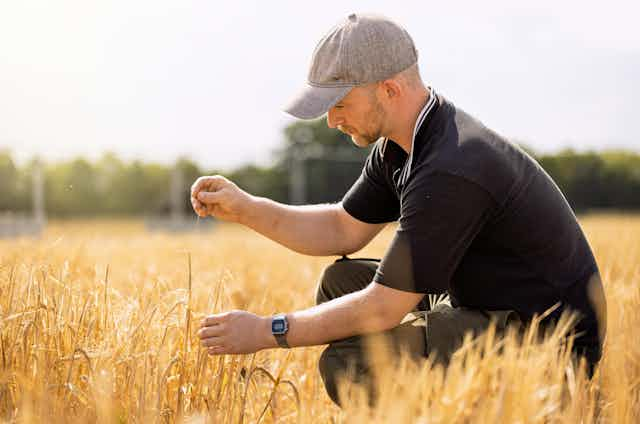Plants are among the most intrepid explorers on Earth. Roughly 460 million years ago, the first plants started leaving lakes and rivers and appeared on land. At that time, the surface of Earth was mostly bare rock.
These pioneers had to overcome extraordinary challenges as they transitioned from their aquatic lifestyle. The crops we grow to feed ourselves now are struggling to adapt to the new extremes in our climate. But there is a way to help protect them: reawaken their ancient resilience.
All plants require 17 nutrients for life. Nitrogen, phosphate and potassium are the most important ones. A limited supply of any one of these stunts the plant’s growth.
So for millennia humans have domesticated crops to maximise production and to make sure plants had a sufficient supply of the nutrients they needed. Our ancestors collected and spread nightsoil (human faeces) on fields to fertilise them and battled over lands covered in nutrient-rich bird guano. More recently, humans have created a global trade in synthetic nitrogen fertilisers. The rise of human civilisation is intertwined with the use of plant nutrients in agriculture.

Many people think of plants as nice-looking greens. Essential for clean air, yes, but simple organisms. A step change in research is shaking up the way scientists think about plants: they are far more complex and more like us than you might imagine. This blossoming field of science is too delightful to do it justice in one or two stories. This article is part of a series, Plant Curious, exploring scientific studies that challenge the way you view plantlife.
These human-led practices may have boosted food production but they have also made crops lazy.
Ancient connections
Plants once had to adopt ingenious evolutionary solutions to survive on land. One way they evolved was to forge a symbiotic (mutually beneficial) relationship with soil fungi, arbuscular mycorrhizal, which acted like primitive roots to help these early plants access nutrients from the land. In exchange, fungi received the energy plants harvested from photosynthesis.
Our farming practices have suppressed these symbiotic relationships.
Instead, we rely on chemical fertilisers to grow our food, which are responsible for both greenhouse gas emissions and agricultural pollution, and are largely unaffordable for smallholder farmers, who grow a third of the global food supply.
Far from being ancient history, however, I believe these symbiotic microbial relationships are still relevant to how we should or could be producing our food today.
Plants eventually evolved their own roots some 350-400 million years ago, but they continued tapping into this fungal relationship to help absorb nutrients from the land and soil.
Then, around 100 million years ago, some plants – what we now know as the legume family, including beans, peas, and lentils – developed a relationship with bacteria in the soil. The bacteria, called rhizobia, infect the roots of legumes and use an enzyme to break down nitrogen from the air into a substance accessible to the plant.

Wild plants still use these primeval associations to get these crucial nutrients. The traits plants need to switch on the symbiotic relationships lie mostly dormant or underused in the world’s food production systems.
Promising research
Scientists are working to understand how plants engage with these soil microorganisms, so we can reactivate them. Food production must increase to feed the world’s growing population. Yet it is unsustainable in its current form, with around half of the global population reliant on fertiliser for food production. The synthetic nitrogen supply chain alone produced an estimated 10% of agricultural greenhouse gas emissions in 2018 and is often out of reach for smallholder farmers in Africa, who are working with some of the most depleted land in the world.
Recent research into plant genes has told us something with profound implications. Our cereal crops have the same ancient genetic pathway as legumes do, which allow them to engage with nitrogen-fixing bacteria.
When legumes evolved the ability to associate with nitrogen-fixing bacteria 100 million years ago, they used many of the processes already present in their biology to interact with arbuscular mycorrhizal fungi. Cereals missed this evolutionary trick: they had already diverged, in evolutionary terms, from legumes.
The good news is that early research suggests it is possible to transfer legumes’ unique nitrogen-fixing properties to other food crops.
Over the last few years, researchers have dramatically increased our understanding of how plants engage with beneficial microorganisms. In the laboratory at least, we can encourage cereal crops to interact more proactively with beneficial fungi, in conditions that replicate a highly fertilised field and to begin to recapitulate the processes that we see in legumes necessary to accommodate nitrogen-fixing bacteria. Researchers are retraining plants to seek out beneficial microorganisms.
These discoveries are vital to developing cereals that can fix nitrogen without our help and access other essential nutrients through interactions with fungi. We now know that all plants have the fundamental mechanism that, up until now, only legumes have used to allow interactions with beneficial bacteria.
We can make our crops engage more proactively and productively with beneficial fungi and bacteria. And we don’t need to start from scratch to engineer cereals to be more independent.
However, it won’t be easy. There are several complicated processes involved in transferring the ability to fix nitrogen to cereals, which include developing the function to recognise beneficial bacteria.
While still in early discovery, research suggests it may be possible to grow crops without huge amounts of chemical fertilizer in the future. This has the potential to benefit smallholder farmers in low-income countries who lack access to fertilisers, and could also provide much needed reductions of agriculture’s pollution and greenhouse gas emissions. It also has the promise of potentially reducing the impact of shocks such as fertiliser shortages and price spikes.
Although plants’ underground relationships with microorganisms largely go unseen, they might hold the keys to major breakthroughs in the future of farming.

